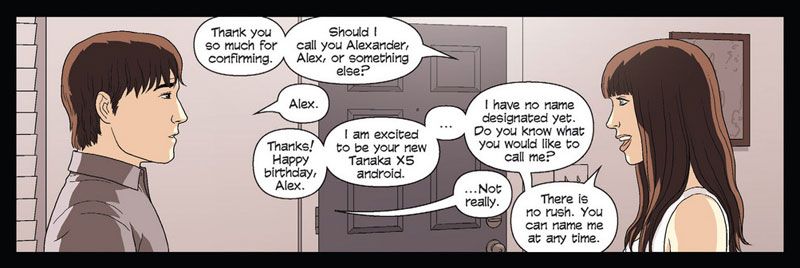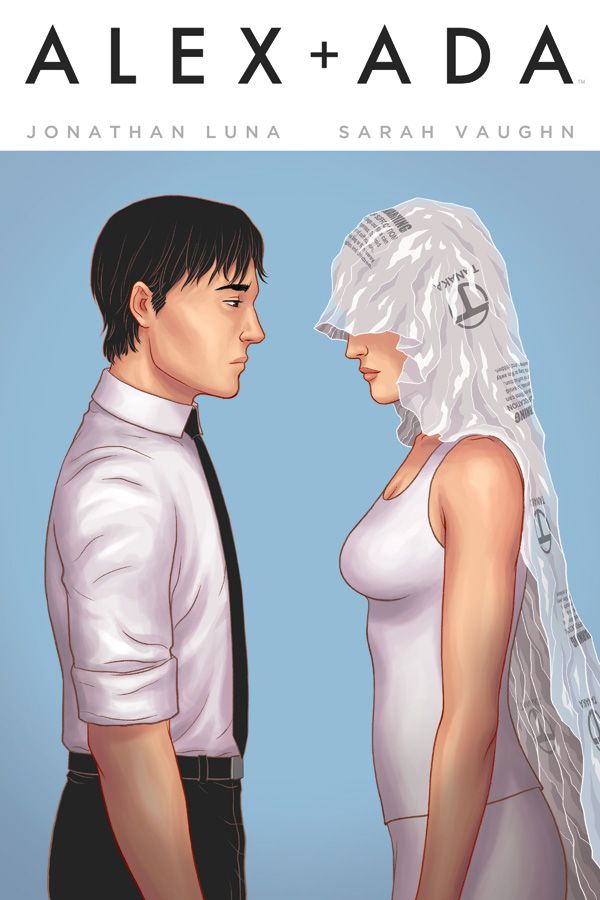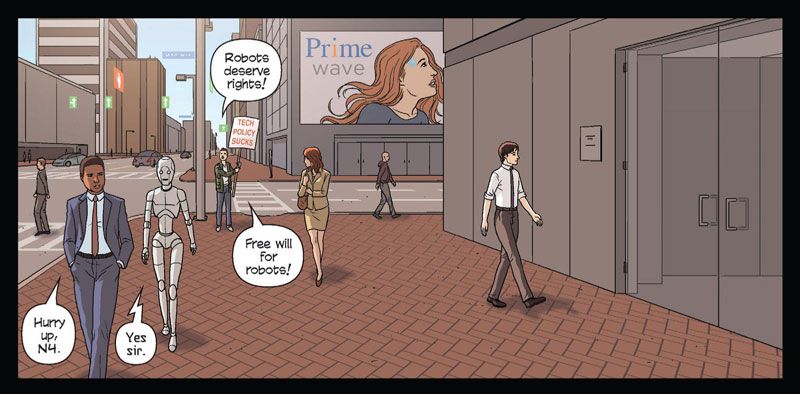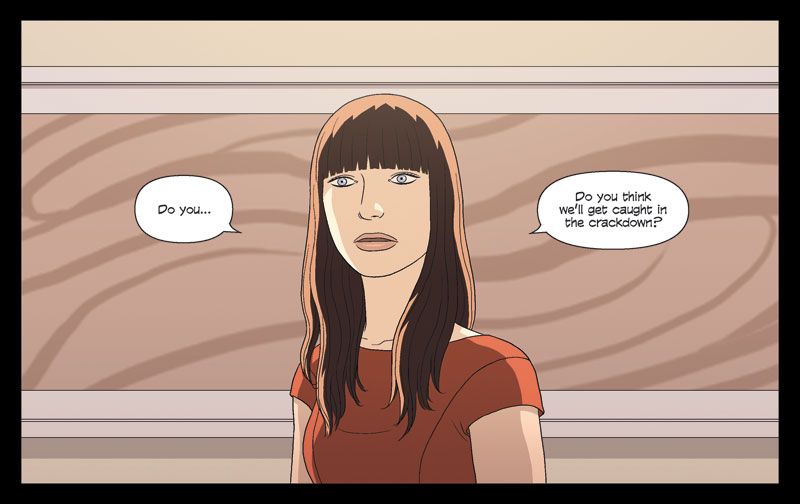Alex + Ada is one of the very few stories that I cannot wait for, and so I’m reading every 20 pages in each monthly installment. I hate waiting a month, so I definitely couldn’t wait for the trade paperback. You’re lucky though, because if you’re interested in jumping on now, the first 6 issues have already been collected into the first volume.
People often ask what single-issue comic books I still read, particularly since the Alternative Press Expo, when my purchases made it obvious that I’ve moved firmly (if a little reluctantly) into the camp of people who now wait for compilations to read stories all at once. It isn’t that Alex + Ada is so terribly dramatic that I MUST read it as soon as possible, it isn’t that it ends on some goofy cliffhanger each month. I began reading because this is EXACTLY the type of story I have been wanting to read for years, I’ve waited long enough! But I keep reading because it is evolving into something really beautiful, clever, and necessary.
(Now I’m going to summarize the book so that you’ll know what I’m talking about, I’ll try not to spoil anything by mapping out the premise, but if you’re as averse to spoilers as I am, you might want to skip the following paragraph.)
Alex + Ada is set in a not-too-distant future where Alex is a slightly lonely single young man who is given an artificial human girlfriend. Initially he’s uncomfortable owning and living with what is essentially a subservient sex toy, so he quickly finds out how to unlock her artificial intelligence. He wants to enable Ada to become an autonomous individual in her own right, which is laudable, but he doesn’t think through the consequences. Unfortunately in this society artificial intelligence is illegal, which means that Ada can never be free, she will always be in danger, especially without Alex. But at the same time she cannot truly learn who she is if she can’t explore the world.
Of course this is interesting, how could it not be? Years ago I discovered the Real Doll and I was absolutely fascinated. In case you aren’t familiar with the concept, a Real Doll is a life-size, life-like doll which people can have sex with. The doll’s are made mainly of a silicon coating over an elaborate metal skeleton which helps to creates realistic movement. What interests me (outside of the idea of engaging sexually with a fake human, which is quite startling), but simply the idea of how someone could live with a Real Doll. The combined weight of the silicon and metal creates a human-like figure which weighs almost as much as an actual human body. Where would you store it? What would you say when people came over? Even the biggest loner in the world probably has one visitor a year, even if it’s just a landlord or a family member. What do you say about the fake body you keep in your bed, or a closet, or do you sit in in an armchair like Norman Bates with his mother? There are just so many questions, and that isn’t even considering what it would feel like to repeatedly have sex with a life-like doll and how that could impact a person’s attachment to that doll.
Jonathan Luna’s art on the book is, as always, cool as a cucumber. His elegant color palette and minimal design elements conspire to create a feel reminiscent of classic science fiction movies like THX1138 or Fahrenheit 451. The delicacy and austerity of his line work often belies the passion of the story, allowing insane situation to become more palatable for us as readers. It is within the meditative quality of his art that the story blossoms, tiny facial ticks and subtle moments of intimacy reveal the anguish beneath each apparently basic moment depicted.
Along with his brother Joshua, Jonathan Luna has a history of creating comic books which (usually obliquely) examine the gender divide. It isn’t generally the main crux of their stories, but for some reason these brothers seem to have an interest in the changing dynamic between the sexes. With a book like Ultra the story ostensibly followed the fame and lifestyle of superheroes, but they took the story in an interesting direction by highlighting the weird power dynamic between a female superhero and her regular, human boyfriend. In Girls they depicted a small town trapped in a bubble and gradually taken over by naked, identical female aliens who reproduce disturbingly quickly (and easily) by having sex with human men. The arguments between the trapped men and women of the town escalate and the sexual component of the alien invasion becomes a huge bone of contention as unhealthy relationships dissolve under the pressure of the situation. In The Sword a weak, self-hating, disabled woman watches her family destroyed by gods, is healed by her father’s magic sword, and embarks on a journey of vengeance. On her horrific journey she discovers previously unplumbed depths of strength, breaking every assumption she had about herself as a young woman and as a person. Letting herself become what she must in order to do battle takes her far beyond any role she had mapped out for herself, and changes her irreparably.
Working with writer Sarah Vaughn on Alex + Ada, Jonathan Luna appears to have finally taken a step towards a more overt examination of inequality. What began as a cute science fiction book which might examine the weird reality of living with a compliant artificial human has become a scathing indictment of inequality in our society. The metaphor of artificially intelligent beings living out their secret lives, unsafe and insecure, yet potentially stronger and smarter than humans is potent. The entire premise is just different enough from our world to make it entertaining instead of depressing. Yet it is close enough to reality and the way we treat each other to be heartbreakingly engaging. I cannot wait for the next issue.





